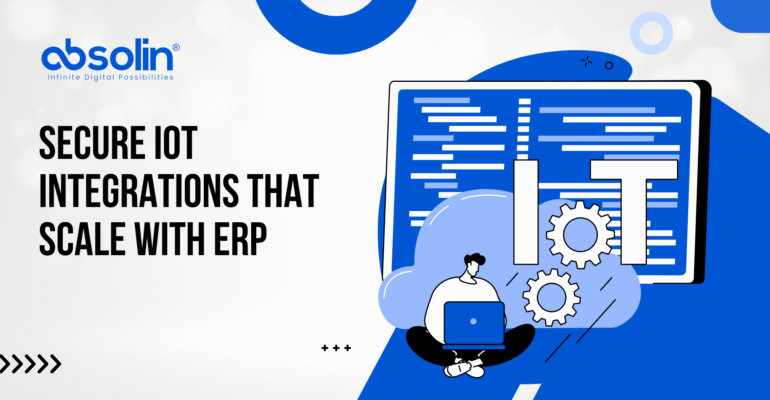From Sensor to ERP: A Practical Guide to Web and Mobile IoT Integration

From Sensor to ERP: A Practical Guide to Web and Mobile IoT Integration
Walk into a modern factory, warehouse, or even a logistics hub, and you’ll notice something subtle: it’s no longer just humans running the show. Machines talk. Sensors ping. Dashboards glow. Invisible data streams pulse through the air that transform everyday operations into real-time intelligence.
But here’s the twist: collecting sensor data is easy. Turning that data into actionable business decisions is where the real value lies. And that’s where IoT integration from the tiniest sensor to the heart of your ERP system makes all the difference.
When IoT devices seamlessly connect to ERP, data doesn’t just sit on a dashboard; it flows directly into the workflows, automations, and decisions that run your business. This is where operational visibility meets strategic control and where innovation moves from theory to practice.
1. Why IoT Integration Matters More Than Ever
IoT devices are generating more data than ever, from manufacturing equipment and energy meters to fleet tracking devices and healthcare wearables. But without proper integration, this data remains trapped in silos.
Key reasons why integration is critical:
- Real-time insights instead of delayed reports
- Predictive maintenance to prevent costly downtime
- Accurate inventory and asset tracking
- Faster response to changing conditions
- Automated workflows that eliminate manual errors
IoT becomes truly powerful when it connects with the systems that power business decisions through your ERP and web or mobile platforms.
2. How IoT Data Flows from Sensor to ERP
Let’s break down the journey step by step:
Step 1: Data Collection at the Edge
IoT sensors gather raw data such as temperature, location, vibration, usage, humidity, speed, or any parameter relevant to the business process.
Step 2: Data Transmission
Through protocols like MQTT, HTTP, CoAP, or WebSockets, data is transmitted securely to gateways or cloud platforms in near real time.
Step 3: Data Processing and Filtering
Edge devices or cloud systems filter and preprocess data, separating noise from valuable signals to reduce overload.
Step 4: Integration with ERP
APIs or middleware push the processed data into ERP modules like inventory, production, logistics, quality control, or finance.
Step 5: Actionable Insights via Web and Mobile Apps
Managers and operators get real-time alerts, dashboards, and reports which enable fast decisions, remote control, and automated responses.
3. Real-World Use Cases of IoT-ERP Integration
🏭 Manufacturing: Predictive Maintenance
- IoT sensors: Monitor machine vibration and temperature.
- ERP integration: Triggers automated maintenance tickets when thresholds are breached.
- Outcome: Reduced downtime, extended machine life, and optimized resource planning.
🚛 Logistics & Supply Chain: Real-Time Fleet Tracking
- IoT sensors: GPS and environmental sensors track truck location and cargo conditions.
- ERP integration: Updates delivery status and triggers notifications for route deviations.
- Outcome: Improved delivery accuracy, reduced losses, and higher customer satisfaction.
🏢 Smart Buildings & Facilities:
- IoT sensors: Monitor energy consumption, occupancy, and air quality.
- ERP integration: Automates energy usage reports and triggers HVAC adjustments.
- Outcome: Lower operational costs and sustainability compliance.
🏪 Retail & Inventory Management:
- IoT sensors: RFID tags and smart shelves track product movement in real time.
- ERP integration: Updates stock levels automatically, triggering reorders when thresholds are reached.
- Outcome: No stockouts, optimized inventory, and reduced waste.
4. Key Components of a Successful IoT Integration Strategy
1. Robust Connectivity and Infrastructure
Stable and secure communication protocols ensure that data travels from the sensor to the ERP without latency or data loss.
2. Secure Data Architecture
End-to-end encryption, authentication protocols, and regular security audits protect sensitive business data.
3. Scalable Middleware or APIs
A middleware layer acts as a translator between IoT devices and ERP systems, ensuring seamless data flow and compatibility.
4. User-Friendly Web and Mobile Interfaces
Accessible dashboards, alerts, and mobile apps empower decision-makers to act fast, from anywhere.
5. Intelligent Automation & Analytics
AI/ML engines can turn IoT data into predictive models, for example, forecasting demand or preventing equipment failure.
5. Common Challenges in IoT-ERP Integration (And How to Overcome Them)
| Challenge | Impact | Solution |
| Disparate systems & legacy ERPs | Integration delays, data silos | Use middleware, standardized APIs, or ERP modernization |
| Data security & privacy | Risk of breaches or regulatory non-compliance | Implement strong encryption, IAM, and compliance checks |
| Volume & velocity of IoT data | Overload and slower processing | Filter data at the edge and use scalable cloud architecture |
| Real-time decision-making | Delays and inefficiencies | AI-driven alerts and workflow automation |
| Lack of internal expertise | Integration failures or poor ROI | Partner with experienced IoT and ERP solution providers like Absolin |
6. Steps to Plan and Execute a Successful Integration
- Define your business goals – Are you optimizing maintenance, logistics, or supply chain visibility?
- Identify critical data points – What needs to be measured and why.
- Choose the right IoT infrastructure – Sensors, connectivity, and protocols.
- Select integration architecture – APIs, middleware, or direct ERP integration.
- Design user experience – Web and mobile dashboards should drive action, not just display numbers.
- Prioritize security and compliance – From data encryption to access control.
- Test, scale, and optimize – Start with a pilot before scaling across the organization.
Conclusion: Where Machines Meet Meaning
IoT on its own is powerful, but IoT connected to ERP is transformational. It bridges the physical and digital worlds, turning raw data into meaningful action. Every sensor reading is no longer just a number; it’s a decision waiting to happen, a problem solved before it escalates, a customer served better, and a business made stronger.
When IoT, ERP, web, and mobile platforms work in harmony, businesses don’t just run operations, they orchestrate intelligent ecosystems that can adapt, scale, and thrive. In a world driven by data, the winners will be those who master connection.
Where Absolin Can Help
At Absolin, we help businesses move from collecting data to creating impact. Our experts specialize in end-to-end IoT and ERP integration, connecting your sensors, devices, web, and mobile platforms to your business core.
We offer:
- Custom IoT integration architectures built for scalability and security.
- API and middleware solutions that bridge even the most complex legacy ERPs.
- Real-time web and mobile dashboards for operational visibility.
- AI-powered analytics to turn IoT data into predictive intelligence.
- Security and compliance frameworks that keep your data safe.
With Absolin, your IoT data doesn’t just float in the cloud, it flows with purpose, driving efficiency, agility, and growth.


